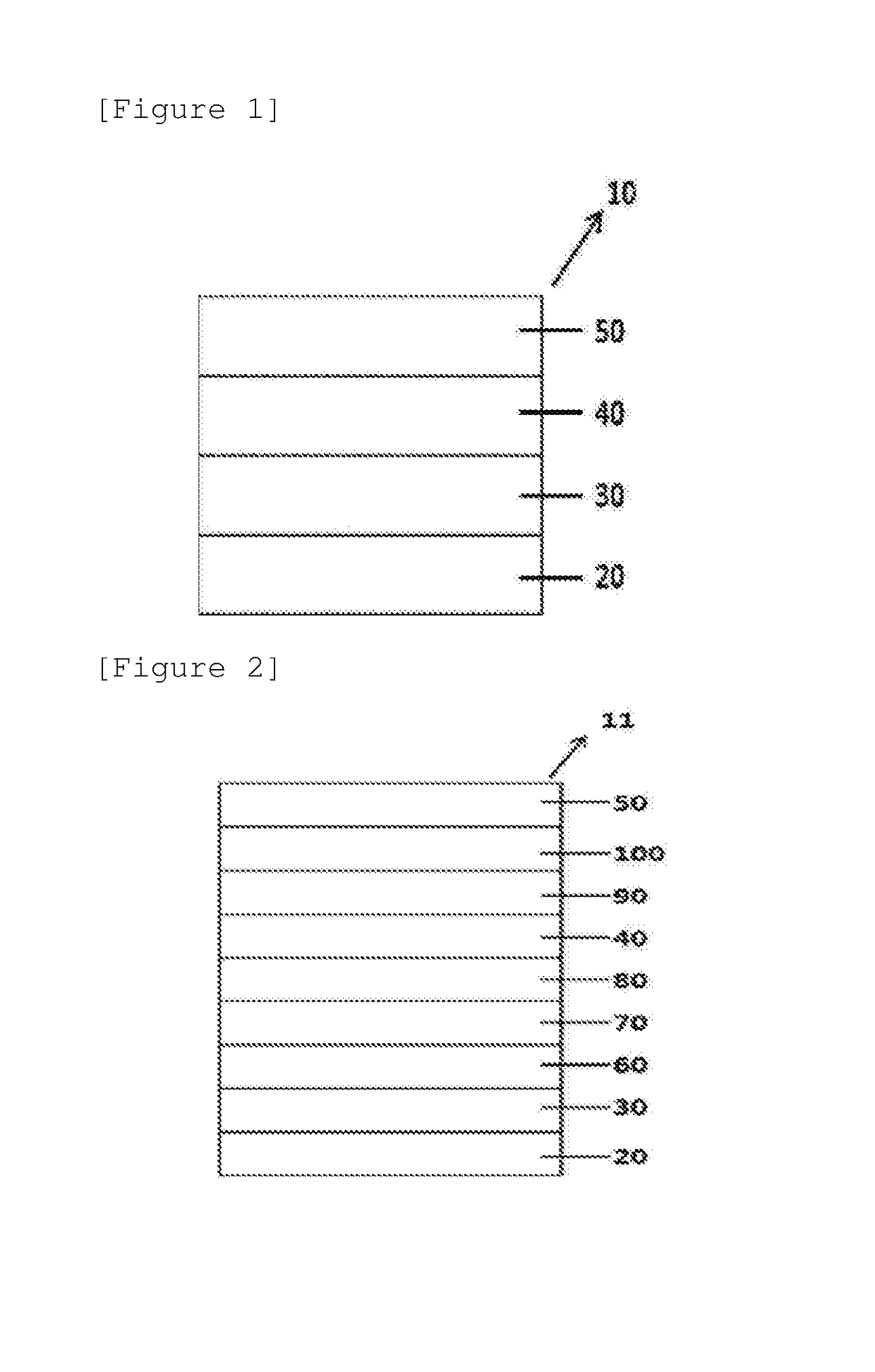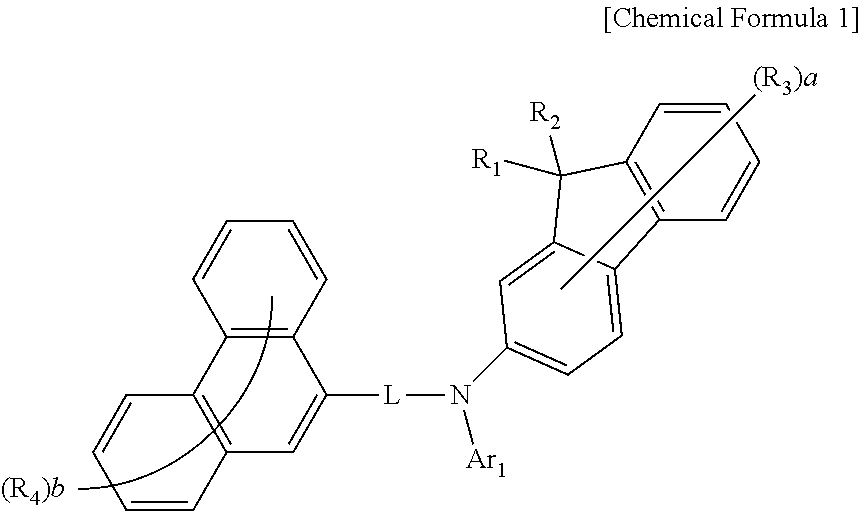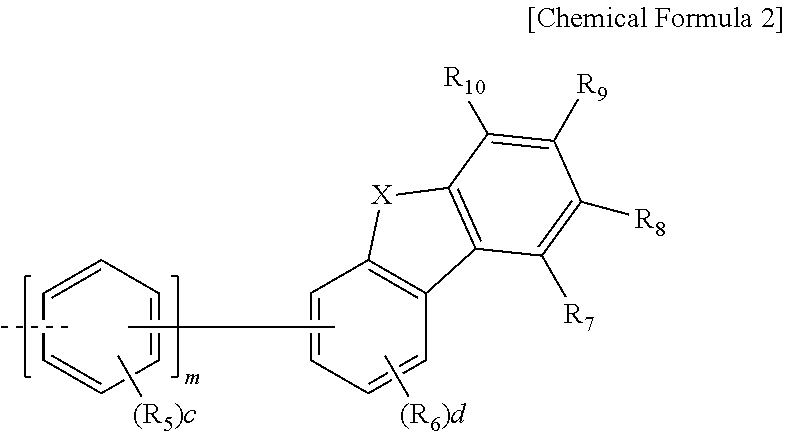Compound and organic electronic device comprising same
a technology of organic electronic devices and organic materials, which is applied in the direction of organic chemistry, germanium organic compounds, triarylamine dyes, etc., can solve the problems of insufficient development of stable and efficient materials for organic light emitting devices, color purity deterioration, and device efficiency reduction, so as to improve light efficiency and reduce the driving voltage of organic electronic devices , the effect of enhancing the service life characteristics of the devi
- Summary
- Abstract
- Description
- Claims
- Application Information
AI Technical Summary
Benefits of technology
Problems solved by technology
Method used
Image
Examples
preparation example 1
Synthesis of Compound 1-1
[0206](1) Synthesis of Compound A
[0207]Under a nitrogen atmosphere, 9-bromophenanthrene (50.0 g, 195.31 mmol) and 2-amino-9,9-dimethylfluorene (42.86 g, 205.08 mmol) were completely dissolved in 250 ml of toluene, and then sodium-tert-butoxide (22.52 g, 234.38 mmol) was added thereto, and the resulting mixture was stirred while increasing the temperature until the resulting mixture was refluxed. When the mixture began to be refluxed, bis(tri-tert-butylphosphine)palladium (0.35 g, 0.68 mmol) was slowly added dropwise thereto. After 3 hours, the reaction was terminated, the temperature was lowered to normal temperature, the resulting product was concentrated under reduced pressure, and then the residue was recrystallized with 250 ml of ethyl acetate to prepare Compound A (50.47 g, yield: 67%).
[0208]MS[M+H]+=386
[0209](2) Synthesis of Compound 1-1
[0210]Under a nitrogen atmosphere, Compound A (10.0 g, 22.99 mmol) and 1-(4-bromophenyl)naphthalene (5.89 g, 20.89 mm...
preparation example 2
Synthesis of Compound 1-2
[0212]
[0213]Under a nitrogen atmosphere, Compound A (10.0 g, 22.99 mmol) and 2-(4-bromophenyl)naphthalene (5.89 g, 20.89 mmol) were completely dissolved in 210 ml of xylene in a 500 -ml round bottom flask, and then sodium-tert-butoxide (2.61 g, 27.16 mol) was added thereto, bis(tri-tert-butylphosphine) palladium (0.11 g, 0.21 mmol) was put thereinto, and then the resulting mixture was heated and stirred for 4 hours. The temperature was lowered to normal temperature, the resulting mixture was filtered to remove the salt, and then xylene was concentrated under reduced pressure, and the residue was recrystallized with 220 ml of ethyl acetate to prepare Compound 1-2 (11.52 g, yield: 79%).
[0214]MS[M+H]+=638
preparation example 3
Synthesis of Compound 1-3
[0215]
[0216]Under a nitrogen atmosphere, Compound A (10.0 g, 22.99 mmol) and 2-(4-bromophenyl)-9,9-dimethyl-9H-fluorene (7.27 g, 20.89 mmol) were completely dissolved in 230 ml of xylene in a 500 -ml round bottom flask, and then sodium-tert-butoxide (2.61 g, 27.16 mol) was added thereto, bis(tri-tert-butylphosphine) palladium (0.11 g, 0.21 mmol) was put thereinto, and then the resulting mixture was heated and stirred for 4 hours. The temperature was lowered to normal temperature, the resulting mixture was filtered to remove the salt, and then xylene was concentrated under reduced pressure, and the residue was recrystallized with 280 ml of ethyl acetate to prepare Compound 1-3 (13.66 g, yield: 84%).
[0217]MS[M+H]+=704
PUM
| Property | Measurement | Unit |
|---|---|---|
| Chemical Formula | aaaaa | aaaaa |
| Chemical | aaaaa | aaaaa |
| structures | aaaaa | aaaaa |
Abstract
Description
Claims
Application Information
 Login to View More
Login to View More - R&D
- Intellectual Property
- Life Sciences
- Materials
- Tech Scout
- Unparalleled Data Quality
- Higher Quality Content
- 60% Fewer Hallucinations
Browse by: Latest US Patents, China's latest patents, Technical Efficacy Thesaurus, Application Domain, Technology Topic, Popular Technical Reports.
© 2025 PatSnap. All rights reserved.Legal|Privacy policy|Modern Slavery Act Transparency Statement|Sitemap|About US| Contact US: help@patsnap.com



